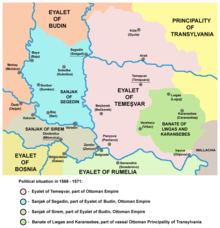This article includes a list of references, related reading, or external links, but its sources remain unclear because it lacks inline citations. (November 2012) |
| Sanjak of Segedin | |||||||||||||||||
|---|---|---|---|---|---|---|---|---|---|---|---|---|---|---|---|---|---|
| Sanjak of the Ottoman Empire | |||||||||||||||||
| 16th century–1699 | |||||||||||||||||
 Sanjak of Segedin as part of the Eyalet of Budin in 1568 | |||||||||||||||||
| Capital | Segedin (Hungarian: Szeged) | ||||||||||||||||
| History | |||||||||||||||||
• Established | 16th century | ||||||||||||||||
| 26 January 1699 | |||||||||||||||||
| |||||||||||||||||
| Today part of | Serbia, Hungary | ||||||||||||||||

Sanjak of Segedin or Sanjak of Szeged (Turkish: Segedin Sancağı; Hungarian: Szegedi szandzsák; Serbian: Сегедински санџак) was an administrative territorial entity of the Ottoman Empire formed in the 16th century. It was located in the Bačka (Bácska) region. Initially, it was part of the Budin Province, but in the 17th century it was included into Eğri Province. The administrative center of the Sanjak of Segedin was Segedin. It was captured by the Habsburg monarchy between 1686-1688, who formally annexed it according to Treaty of Karlowitz in 1699.